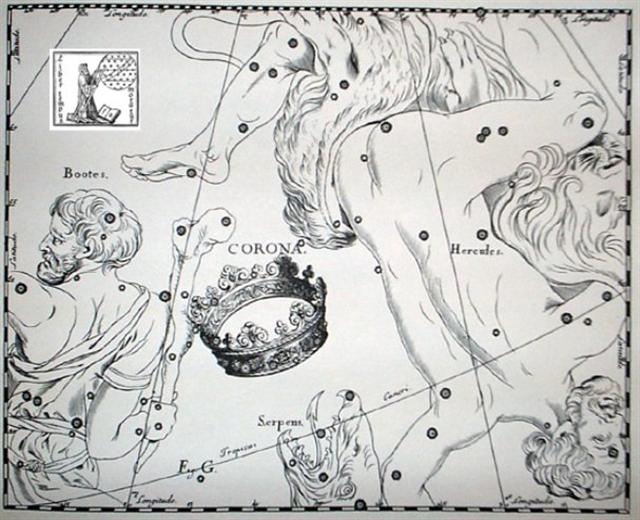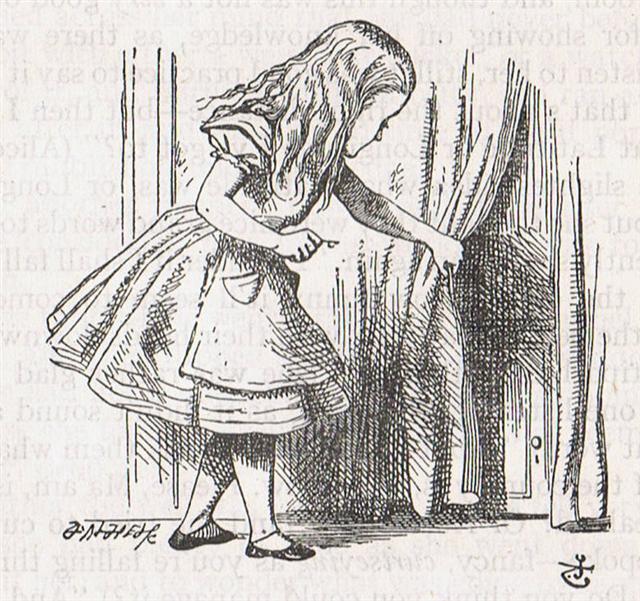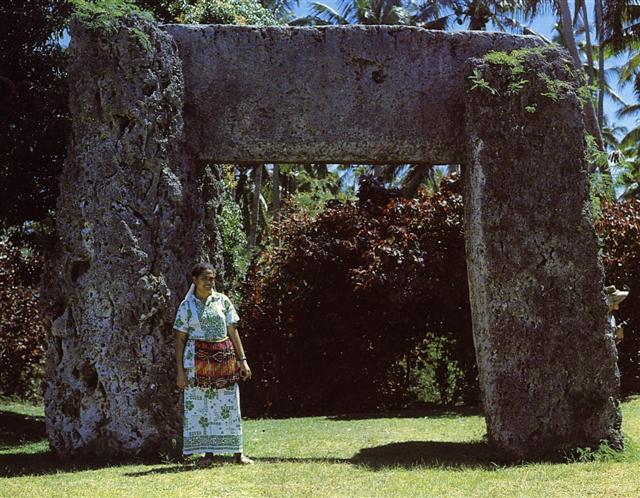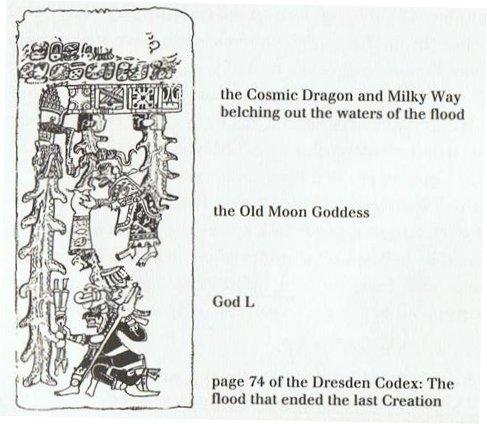|
584
60 The beginning of the year came when cold fresh water ran down from the melting snows on the mountain top(o)s:
And the end was at the Castle of Arianrhod: ... In other words, the ancient Druidic religion based on the oak-cult will be swept away by Christianity and the door - the god Llyr - will languish forgotten in the Castle of Arianrhod, the Corona Borealis. This helps us to understand the relationship at Rome of Janus and the White Goddess Cardea who is ... the Goddess of Hinges who came to Rome from Alba Longa. She was the hinge on which the year swung - the ancient Latin, not the Etruscan year - and her importance as such is recorded in the Latin adjective cardinalis - as we say in English 'of cardinal importance - which was also applied to the four main winds; for winds were considered as under the sole direction of the Great Goddess until Classical times ...
... The distance from the culmination of Alphekka Meridiana (α Coronae Borealis) to the culmination of Fomalhaut (α Piscis Austrini - or Notius) was 298 (October 25) - August 13 (225) = 73 days → 584 / 8 = 365 / 5 ... However when the Sun was moving down out of sight from the horizon in the west in order to travel to the horizon in the east he had to go withershins, i.e. the correct distance should reasonably be counted as 364 - 73 = 292 (4 * 72) days. And 472 (number of glyphs on the G tablet + 1) might have been used as a cue (key) for the first half of a year (vaka), because 2 * 92 = 184.
Hipu. Calabash, shell, cup, jug, goblet, pot, plate, vase, bowl, any such receptacle; hipu hiva, melon, bottle; hipu takatore, vessel; hipu unuvai, drinking glass. P Mgv.: ipu, calabash, gourd for carrying liquids. Mq.: ipu, all sorts of small vases, shell, bowl, receptacle, coconut shell. Ta.: ipu, calabash, cup, receptacle. Churchill.
348 (number of glyphs on side b of the C tablet ↔ 12 * 29) - 11 (Cb1-11) = 337 (→ 48 weeks + 1 day), and together with the first 143 glyphs on side a this will amount to 480 days → 491 (→ 4 * 91 = 364) - 11 → 91 - 80 = 11. The Grgorian year did not begin immediately after the December solstice (day 355) but 11 days later. But we should remove my assumed epagomenal period of 73 (= 584 / 8 = 365 / 5) days. And we should presumably measure from Cb1-9 instead of from Cb1-11. 491 - 73 + 2 = 420 → 6 * 70 = 7 * 60. 480 - 73 + 2 = 409 → 408 (Gb6-26, Sirrah) + 1. → Sir-rah (408) - Sir-ius (181) = 227 → 22 / 7 = π →
... Together with the fingers on the left hand (4 + 1) the total becomes 9 + 2 = 11 ...
In which case the relevant distance ought to be 402 (Cb1-9) - Ca6-6 (146 → 2 * 73 → September 30) = 256 (= 73 + 183 = 16 * 16). At 14 February (Day of all the 'Hearts')
... In the inscriptions of Dendera, published by Dümichen, the goddess Hathor is called 'lady of every joy'. For once, Dümichen adds: Literally ... 'the lady of every heart circuit'. This is not to say that the Egyptians had discovered the circulation of the blood. But the determinative sign for 'heart' often figures as the plumb bob at the end of a plumb line coming from a well-known astronomical or surveying device, the merkhet. Evidently, 'heart' is something very specific, as it were the 'center of gravity' ... See Aeg.Wb. 2, pp. 55f. for sign of the heart (ib) as expressing generally 'the middle, the center'. And this may lead in quite another direction. The Arabs preserved a name for Canopus - besides calling the star Kalb at-tai-man ('heart of the south') ... Suhail el-wezn, 'Canopus Ponderosus', the heavy-weighing Canopus, a name promptly declared meaningless by the experts, but which could well have belonged to an archaic system in which Canopus was the weight at the end of the plumb line, as befitted its important position as a heavy star at the South Pole of the 'waters below'. Here is a chain of inferences which might or might not be valid, but it is allowable to test it, and no inference at all would come from the 'lady of every joy'. The line seems to state that Hathor (= Hat Hor, 'House of Horus') 'rules' the revolution of a specific celestial body - whether or not Canopus is alluded to - or, if we can trust the translation 'every', the revolution of all celestial bodies. As concerns the identity of the ruling lady, the greater possibility speaks for Sirius, but Venus cannot be excluded; in Mexico, too, Venus is called 'heart of the earth'. The reader is invited to imagine for himself what many thousands of such pseudo-primitive or poetic interpretations must lead to: a disfigured interpretation of Egyptian intellectual life ... we can see 5 double feathers at left (→ 5 * 73 = 365 = 354 + 11 → 584 - 573 = 11), surely to be counted as a sign of past tense:
→ 146 = 2 * 73 = 46 + 100. ... Allen has documented all his star culminations at 21h, which could be due to an effort of keeping the culminations at their proper places according to the ancients, 24h (spring equinox) - 21h = 3h = 24h / 8 = 45º. 3h corresponds to 366 / 8 = 45.75 of my right ascension days and *366 - *46 = *320 (Dramasa, σ Octantis) ... .→ 254 = 354 - 100 = 464 - 210 (= 420 / 2) = 400 - 2 * 73. ... The Sacred Book of the ancient Maya Quiche, the famous Popol Vuh (the Book of Counsel) tells of Zipacna, son of Vucub-Caquix (= Seven Arata). He sees 400 youths dragging a huge log that they want as a ridgepole for their house. Zipacna alone carries the tree without effort to the spot where a hole has been dug for the post to support the ridgepole. The youths, jealous and afraid, try to kill Zipacna by crushing him in the hole, but he escapes and brings down the house on their heads. They are removed to the sky, in a 'group', and the Pleiades are called after them ... I am here using the implication sign (→) rather freely, at this stage not spending much time and effort to trim them down. Number 256 was used in the G text in order to pinpoint the location of Dramasa (400 - 80 = *320), the south pole star:
The stars were presumably counted according to a year with 2 * 183 = 366 right ascension days and therefore it would be convenient to at some point change from heliacal days to nakshatra nights (or the opposite) in order to avoid troubles caused by the fact that 366 ≠ 365¼. And if we had counted from October 22 (295) to August 12 (224) the result would have become 740 - 398 (Cb1-6) + 144 - 73 = 342 + 144 - 73 = 413 = 14 * 29½, i.e. one week shorter than 420 - like a seven-day wake: ... The month, which takes its name from Juppiter the oak-god, begins on June 10th and ends of July 7th. Midway comes St. John's Day, June 24th, the day on which the oak-king was sacrificially burned alive. The Celtic year was divided into two halves with the second half beginning in July, apparently after a seven-day wake, or funeral feast, in the oak-king's honour ... When counting 73 epagomenal days correspondingly in the A text we should search for glyph number 1334 + 4 - 73 = 1265 = 664 + 601:
Hemo. Tu. hemo, to disclose, to reveal. Mgv. emo, separated, broken off. T. hemo, conquered, to escape. Mq. hemo, to separate. H. hemo, to unloose. Churchill.
→ 264 = 118 + 2 * 73. → 300 - 70 = 230 = 80 - 70 + 220.
78 - 4 = 74:
|
||||||||||||||||||||||||||||||||||||||||||||||||||||||||||||||||||||||||||||||||||||||||||||||||||||||||||||||||||||||||||||||||||||||||||||||||||||||||||||||||||||||||||||||||||||||||||||||||||||||||||||||||||||||||||||||||||||





















